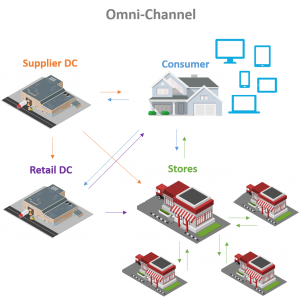By Ian Hobkirk
President, Commonwealth Supply Chain Advisors
In Part I of this two-part blog post I explored three different e-commerce scenarios currently being used by manufacturers and retailers: Manufacturers Filling E-Commerce Orders Directly to their Consumer Clients; Manufacturers Filling e-Commerce Orders on Behalf of Retailers Scenario; and Pure E-Commerce Retailers. In this blog, Part II, I’ll outline three additional scenarios.
Scenario #4: Multi-Channel or Omni-Channel Retailers
 Multi-channel or omni-channel retailers (i.e., those with a retail or wholesale channel in addition to direct-to-consumer) require a combination of several strategies to address their e-commerce needs. Like the manufacturers from Scenario #1 (covered in Part I of this blog post), multi-channel retailers can regulate their levels of e-commerce, and make the transition into this channel more gradually. Among this group, there are a number of strategies which have been used successfully, depending on the nature of the demand.
Multi-channel or omni-channel retailers (i.e., those with a retail or wholesale channel in addition to direct-to-consumer) require a combination of several strategies to address their e-commerce needs. Like the manufacturers from Scenario #1 (covered in Part I of this blog post), multi-channel retailers can regulate their levels of e-commerce, and make the transition into this channel more gradually. Among this group, there are a number of strategies which have been used successfully, depending on the nature of the demand.
This was an early strategy in response to the e-commerce shift, and it’s still practiced more and more every day as traditional retailers become omni-channel companies. Consumer orders are sent to the nearest retail store for fulfillment in order to reduce freight costs and improve service levels. However, in most instances, store associates are not well trained in packing and shipping processes. Picking e-commerce orders may be viewed as an interruption to the normal day’s work and priority may not be given to making timely shipments. The customer experience may vary greatly depending on the store from which the shipment is made. It is important to note that in the age of omni-channel, many retailers are making “ship-from-store,” a focus and investing in the technologies and training required to perform this function efficiently.
Some companies have adopted a hybrid approach which involves filling e-commerce orders from the distribution center as a matter of practice, but only if sufficient inventory does not exist in the distribution center (DC) to fill the order from a local store’s inventory as a last resort. This practice allows for some centralization and control of e-commerce orders, while still leveraging the store infrastructure as the last line of defense to ensure good customer service.
Scenario #5: Companies Outsourcing the E-Commerce Channel
Some companies determine that e-commerce logistics simply does not integrate well into their supply chain infrastructure, and choose to outsource this distribution to a trading partner. For example, many retailers choose to outsource portions of their e-commerce to vendors, having them drop-ship orders directly to their consumer clients. While not alleviating the need for handling direct-to-consumer shipments, a percentage of the distribution center’s volume can be reduced by using vendors in this fashion. Additionally, the retailer does not need to purchase and stock inventory in advance and can realize a real benefit on the balance sheet.
Retailers choosing this strategy are often able to offer a much broader array of items to the general public, as they are not restricted to SKUs which are physically stocked in their distribution centers. Sometimes these SKUs can be offered at a lower cost, since the retailer is not burdened with the need to stock inventory and handle it multiple times.
However, retailers choosing this strategy are highly dependent on their suppliers’ ability to fill these more complex orders. Many of their suppliers may be accustomed to filling large, palletized orders to retail distribution centers, and may struggle with the ability to pick individual items and pack them. Additionally, for retailers that offer a broad selection of SKUs from multiple vendors, this strategy can lead to consumers receiving several shipments for the same order—each originating in a different location. As a result, the consumer experience can be less consistent.
Other companies choose to outsource their direct-to-consumer commerce to a third-party logistics provider (3PL). This can relieve some of the complications of using vendors or other retailers to ship orders, where the fulfilling party may be less than motivated to ensure good customer service. Many 3PLs specialize in high-volume piece-picking and parcel shipping, and are able to handle these orders quickly and efficiently.
In addition, a 3PL’s business consists of filling orders on behalf of others, so they may be better versed in the rigors of specialized labeling and packaging. 3PL contracts can be structured around attainment of certain customer service levels, so the client is able to ensure high levels of service to the consumer. Lastly, some 3PLs have multiple distribution centers, which allow a company the flexibility of utilizing different distribution points as their e-commerce ramps up.
It’s important to note that not all 3PLs are created equal. Many began life as simple public warehouses, better suited to basic pallet handling than the intensities of piece-picking and packing. In addition, many smaller 3PLs have made a surprising underinvestment in basic automation such as real-time warehousing and packing technology. Companies considering a 3PL should engage in a thorough selection process to ensure that they choose a competent partner.
Scenario #6: 3PLs Specializing in e-Commerce
A wide variety of 3PLs offer ecommerce services. Some focus exclusively in direct-to-consumer orders, while others only dabble in it to help their customers whose primary business consists of pallet or case handling. The issue here is that managing e-commerce distribution requires a very specific set of capabilities and enabling technology. In some cases, 3PLs that offer e-commerce but that do not have a defined roadmap for improving efficiency do their clients a disservice, and risk losing their business entirely.
Even if a 3PL doesn’t specialize in e-commerce, it will almost certainly need to offer it on some level or risk losing its core client base. Due to the unpredictability of short, two-to-three year client contracts, most 3PLs are reluctant to invest in large amounts of specialized automation that cannot be easily adapted to other clients’ needs. However, a certain basic set of requirements such as real-time warehousing and an effective forward pick area must be adopted in order to have any credible e-commerce program. A handful of software vendors offer WMS systems that are tailored to the 3PL industry, with features like accessorial billing and tracking ownership of inventory. A modern, web-based WMS can also be an excellent tool to give clients real-time visibility into the status of orders and workflow. (Check out: SaaS WMS – A Look Under the Hood, to read about some of the strengths and weakness of web-based WMS systems)
Finally, 3PLs should initially be selective about which e-commerce accounts they choose to pursue. Starting up a new account can be like driving up a cliff—there is often no gradual ramp-up period. Offering e-commerce to existing clients and gradually introducing automation may be a sound strategy for 3PLs seeking to support this type of order fulfillment.
Now that I’ve explored the various contexts under which companies must fulfill e-commerce orders, my next blog will address the reasons why these orders can present such a challenge in the distribution center. Stay tuned.

